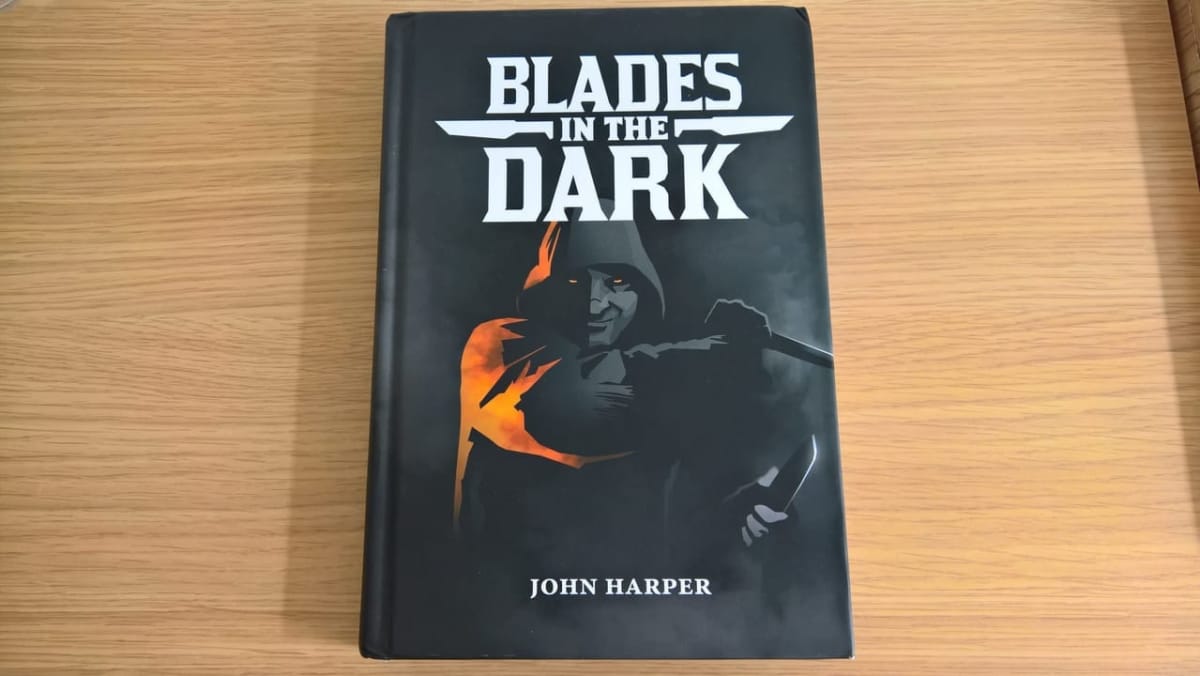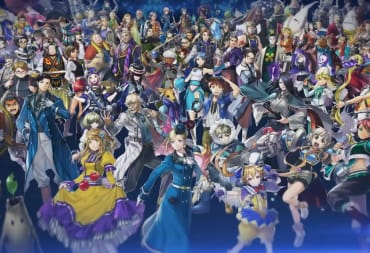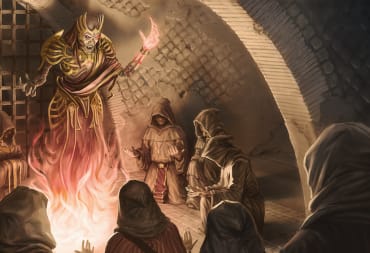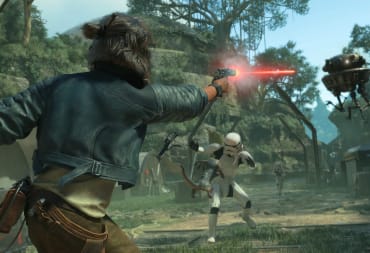Every so often a roleplaying game is released that is so incredible, so inspiring, that it feels like it actually changes roleplaying for me. It's only happened a few times in my roleplaying experience, because for me roleplaying is usually setting first, rules second and the beauty of roleplaying is you can create anything you want, and my group usually bend the setting and system to our wills. I also usually don't like to talk about other game systems in my reviews, or even start reviews this way, but I really want anyone who reads this to realize how important I view this release.
The first game that had an effect on me beyond setting was Deadlands, it had a card drawing mechanic from a regular deck of cards that was used for initiative during combat and character creation. Never before had I felt a rules mechanic so imbedded in the setting that it practically screamed. The next time this happened for me was with Fiasco, and if you've never heard of Fiasco, you really should look it up. Fiasco was game changing because it made me realize again that roleplaying was about stories. For too long I had focused on my character and how they interacted with the setting that the Games Master (GM) was running. Fiasco made me realize that roleplaying is about creating a story with your friends and, good or bad for your character, it's the story and everyone's enjoyment that matters.
I mention these two games and their impact on my roleplaying history for those two reasons; System mechanics that feel entirely at home in the setting and systems focused around creating stories. Blades in the Dark has both of these things, as well as a fast, punchy and very well designed rules system and dark and compelling setting that gives you the ability to create some amazing stories with your group.
If that sounds like your type of game, please, go and buy it, you only need one copy for your group as free downloads are available for all the players. It only uses regular six-sided dice (D6) and its a very quick system to get in to. I won't even feel bad if you don't read the rest of this review if you go and buy it now, but please come back and tell me what you thought of it, and maybe share some of the stories your group created.
If you do want hear more then please read on and let me tell you why Blades in the Dark is such an incredible release.

The Blades in the Dark setting is a dark fantasy Victorian-esque crime drama. Players will create individual characters and then work as a group to create a criminal gang that they are all part of before venturing out into the fantasy city of Duskvol, a city of other criminal gangs in perpetual darkness. The creators describe Duskvol as a mixture of Venice, London and Prague during the 1870's industrial revolution with steam and coal power and basic electrical devices, but it is also a city of fantasy and the world changing event that plunged the world into darkness also changed death, causing the world to become haunted. Cities are protected from these ghosts by lightning towers, powered by blood from demonic terrors that brave hunters regularly harvest.
In most roleplaying games, players create detailed characters and play out full scenes and actions during play session, rolling for most actions with varying degrees of detail depending on the group you are playing with. In a past game using a different system I've played out an entire fish dinner during an important social situation, which felt like it was being played in almost real time. In a standard roleplaying session in many other systems, breaking into a house with a group would be the result of several rolls and actions from each player, with every player involved making a roll for stealth, then one making a roll to pick the lock, or break down the door, followed by more stealth rolls and then several turns of brutal attack action if the players are discovered, and that's not a bad system, but it is a rules focused system.
The Blades in the Dark system summarizes most of the above into a couple of rolls, plunging you into the action. Players will first establish the score, Cassius the Leach has discovered a magic tome that could unleash a violent end for everyone in the area your crew operates, you want to steal it to stop him. Depending on the type of score, the GM will ask for a missing detail. We're looking at Stealth, so our detail is the Point of Infiltration. The sewers! A contact tells us that Cassius the Leach is a known germaphobe and his mistrust of others means that his sewer entrance is never checked. And so our mission begins.
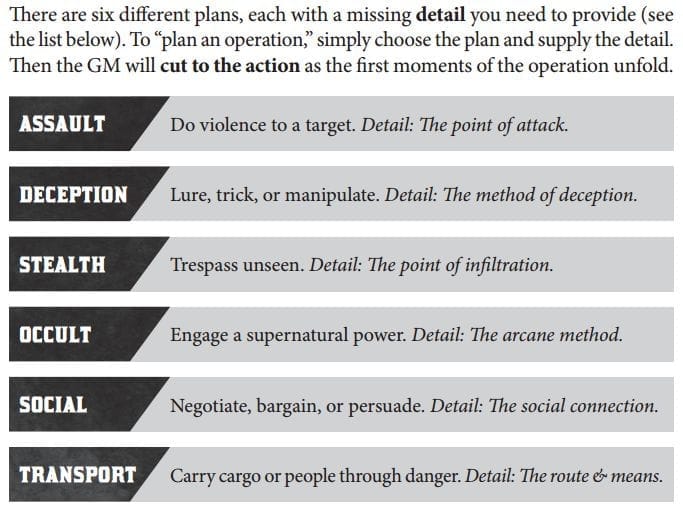
Rolls for Blades in the Dark are extremely simple. You roll a D6 with a roll of 1-3 not great for you, 4-5 is ok, and 6 means a great success. The amount of dice you roll depends on your skill level in the task and some other interesting factors, and you're only looking for your highest dice, so rolling more dice means a greater chance of rolling one high number. Different factors detailed by the GM affect the roll slightly, such as position and effect, and they break down into Controlled, Risky and Desperate and Limited, Standard and Great. So your position might be risky, but the effect might be Great, or it might be risky and limited. Want to headbutt your way through a wall, that sounds desperate/limited, lets go!
In our example above, Dars finds the door to Cassius' home sewer entrance is in a state of disrepair. He's got his lock picking tools that have been handed down by generations of thieves and opening locks is what Dars does. He's in a controlled position with great effect, it doesn't get any easier for Dars. He rolls his dice and his highest is a 6. The door is opened and the crew are in and as far as they know, no one has heard anything.
The rolls that the player's make set up theirs and their opponent's outcomes, so several rolls and long scenes of combat aren't required. The sessions are narrative-driven and punchy.
Dars and his crew bound up the stairs onto the ground floor of the house, and straight into a card game being run by Cassius. Several heavies peel off the walls where they were stood and draw cutlasses and batons as they approach the crew with arrogant smiles. Helena lays a hand on Dars' shoulder as she moves to the front, a sly smile flashes on her face as she draws a blade in one hand from the scabbard on her thigh and a pigs bladder filled with a green gas from inside her coat. 'Remember when we stared into the lightning rods?' she whispers as she throws the pigs bladder into the slow moving rotary fan on the ceiling. Helena gives the code for her allies to close their eyes as she throws a gas bomb into the fan, she wants to blind the heavies so the party can push through the room and head for the library where they know the tome is. It's risky, but this is what Helena does, taking out enemies while they're on the backfoot is her forte. She rolls a 5, which means she does it, but there's a consequence. Cassius also hears the code and closes his eyes, making his way through the smoke and escaping towards the library ahead of the group. Helena and the group knock through the blinded guards, but Helena takes a hit from a wildly swinging heavy with a club and has to be helped from the room.
Several other tools are also available for the GM during play. Clock faces are often used if a task might require more than one roll or attempt. For example; investigating a building to find the location of an item might mean a clock with eight fractions/segments with varying numbers being filled in depending on the success of the player's rolls. Devil's Bargains are also available for the GM to offer to players which give them an extra dice during rolls. Want an extra dice for your roll to seduce the lord of the manor? If you take it, he falls in love with you and won't forget you.
To keep the action moving, flashbacks are also key to avoid lengthy planning sessions. Several guards round the corner as Dars and his crew are trying to break through a door. Flashback to a bar, Dars is sitting with the Guard Sargent, a coin purse slides across the table to the Sergeant who weighs it in his hand and nods. Dars' player rolls to see the outcome of his bribe, the GM adding an extra dice for the sheer amount of coin Dars handed over - Dars gets a 4. The troop of guards continue walking like Dar's crew aren't there and the Guard Sergeant gives Dars a knowing wink. Dars knows there's a consequence to his actions, and he's in the Sergeants debt now, so more payments will be required.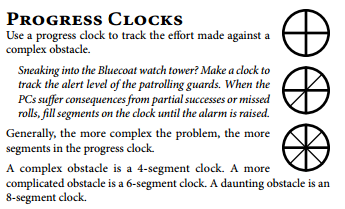
Scores are straight-forward affairs, driven by the narrative and guided by quick rolls. Free play happens before the score, where players decide on the score and take time to prepare, while downtime happens after, where players get a couple of downtime activities for their characters as well as the payoff for the score. After that you're back into the action again.
Seven character types are detailed in the rules as well as six different crew types to suit any given group's play style. Each character and crew type offers unique options, but doesn't bog you down in rules. Character stats are four dots, with a number coloured in during creation. The coloured dots determine the number of dice you start with when rolling with that skill. There are only twelve skills and they are broad in their description. Skills are things like Wreck, or Sway or Hunt, so it's usually immediately clear which skill pertains to a roll for any given action.
The rules for advancing your character with experience earned during scores, as well as expanding your crew and upgrading your lair are detailed, but everything is kept deliberately straight forward and light so that you can focus on the action and narrative, which is what makes Blades in the Dark so beautiful. Running Blades in the Dark for the first time as a beginner GM won't be flawless, and you will need to learn and experience the rules, and even an advanced GM might take some time getting used to the system, but as you and your players embed yourselves in Doskvol, a wide world of fast paced, dark adventure opens up before you.

Blades in the Dark is extremely well produced. The book is the size of a fiction hardback, which is actually perfect for transport in a smaller bag, and the physicality of the book emphasizes the punchiness of the system. The rules are well laid out and straight-forward and, as a GM, everything you need for your players is available online to print for free, including all the character sheets and basic rules for the players. The setting descriptions are deep and detailed and there are plenty of hooks and ideas for you to work with for areas in Doskvol, with several different factions and many NPC's.
If you are a pen and paper roleplayer, or enjoy narrative games, you should try Blades in the Dark. If the setting isn't quite your style, then hacks (mods) are appearing all the time, allowing you to take the system and roll with it. The system is great, simple and will actually improve all of your other roleplaying experiences when you see what a narrative system does for you and your group.
We've skimmed and simplified some Blades in the Dark rules in this review, because just like Blades in the Dark, the importance is on the narrative.
The Bottom Line:
Blades in the Dark is a simple, very well produced narrative driven system. The setting is dark and edgy and the book is full of detail and ideas. Playing Blades in the Dark will actually improve your roleplaying or Games Master skills as it brings your attention back to why we play games, and shows you that creating amazing stories with your friends is far more important that anything else.
Get this game if:
You want a strong narrative driven roleplaying game.
You want to improve your roleplaying experience.
You love a dark, edgy setting.
Avoid this game if:
You don't like roleplaying games, or talking to people in real life.
The copy of Blades in the Dark used for this review was provided by Evil Hat Productions.
If you have played Blades in the Dark or would like to, let us know in the comments below. Especially so if you have played, please share some of your groups stories with us.
Review Summary
Blades in the Dark is an incredible system in a fantastic setting. Anyone interested in roleplaying should give this narrative driven system a go. Everything for the players is provided online for free, so the buy-in is low and the return on investment is great. Play Blades in the Dark and create amazing stories with your friends.
(Review Policy)Have a tip, or want to point out something we missed? Leave a Comment or e-mail us at tips@techraptor.net
